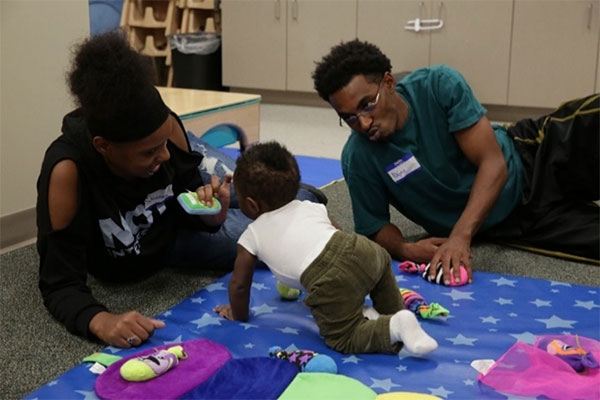Reflections
What do you observe?
Answers may include:
- Mother and child wash the child's hands
- Mother talks to child about what she is doing
- Child rubs her hands together and briefly splashes the water
- Mother uses various words to describe the water and drying her hands
- Child dries her hands on the towel with her mother's help
What strategies did the mother use to support her child's language development?
Answers may include:
- Talking
- Vocabulary:
- Clean, warm, water, cool, dry
- Vocabulary:
- Receptive Language
- Talks about temperature of water, cleaning hands
- Asking questions:
- Is the water cool?
- Are your hands clean?
- Repeating:
- Used descriptive words repeatedly
- Relating language to the routine in which they are engaged
What skills and behaviors in other developmental domains did you observe that would promote school readiness?
Answers may include:
- Cognition
- Active exploration with different textures (e.g., feel of water, towel)
- Asking questions
- Perception, Motor, and Physical Development
- Washing hands before eating
- Rubbing hands together
- Social and Emotional Development
- Mother and child spending time together
- Mother holding child
- Gentle touches of mother helping her daughter to wash her hands
- Mother laughs at something the child says and speaks gently to the child
- Approaches to Learning
- Paying attention
- Curiosity about water
What other routines could the mother use to enhance her child's language development goals?
Answers may include:
- All routines could enhance her goals
- Some examples include:
- Bath time – Develop vocabulary (e.g., washcloth, towel, names of toys or body parts, etc.).
- Toothbrushing – Explore textures, taste (e.g., toothbrush, toothpaste)
- Hair brushing – Enhance receptive language (e.g., talk about hard, soft, shiny, long, short, tangled, etc.).
- Meal preparation
- Ask questions and describe the different foods you are preparing
- Describe what you are doing to prepare food and include the child when possible (e.g., measuring, cutting, cooking)
- Name objects as you set the table
- Describe how various objects are used
- Laundry – Match and name like objects or sort by color
- Read books about everyday routines
- Some examples include:
This video clip shows a home visit where the home visitor and mother are working on the child's communication skills.

 Adults support learning when they plan experiences and are prepared to support a child's interests and discoveries. You and the family use observations, ongoing assessment, the curriculum, the ELOF, and the child's interests to plan learning opportunities for the visit and during the week. Learning opportunities that are planned and structured are more likely to have an effect. The visits are child-focused. It is inevitable that sometimes family members will want to talk about other events in their lives. That is part of having a relationship. When a parent is distracted by personal concerns or crises, you balance listening to the parent and honoring their choice to share concerns with you. It is important to deal with crisis situations while eventually bringing the focus back to the child. In addition to child development, you work with other program staff and community partners to coordinate such services as health, mental health, and oral health services for the family.
Adults support learning when they plan experiences and are prepared to support a child's interests and discoveries. You and the family use observations, ongoing assessment, the curriculum, the ELOF, and the child's interests to plan learning opportunities for the visit and during the week. Learning opportunities that are planned and structured are more likely to have an effect. The visits are child-focused. It is inevitable that sometimes family members will want to talk about other events in their lives. That is part of having a relationship. When a parent is distracted by personal concerns or crises, you balance listening to the parent and honoring their choice to share concerns with you. It is important to deal with crisis situations while eventually bringing the focus back to the child. In addition to child development, you work with other program staff and community partners to coordinate such services as health, mental health, and oral health services for the family.